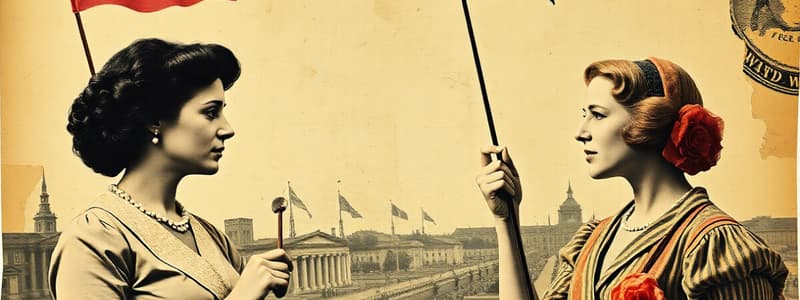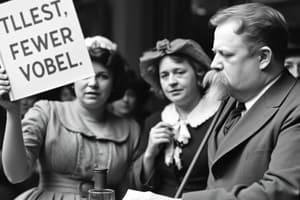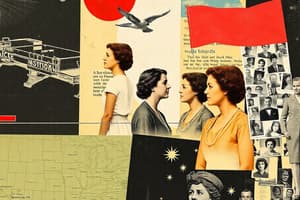Podcast
Questions and Answers
Which of these events occurred in the same year as the U.S. Supreme Court ruling that the Fourteenth Amendment does not grant women the vote?
Which of these events occurred in the same year as the U.S. Supreme Court ruling that the Fourteenth Amendment does not grant women the vote?
- The American Equal Rights Association was formed.
- Susan B. Anthony was arrested for voting in a presidential election. (correct)
- The Equality League of Self-Supporting Women was organized.
- The first nationwide women's rights convention was held in Worcester, MA.
- The first vote on women's suffrage was defeated in the U.S. Senate.
Which of these events directly contributed to the formation of the National Woman Suffrage Association (NAWSA)?
Which of these events directly contributed to the formation of the National Woman Suffrage Association (NAWSA)?
- The passage of the Fifteenth Amendment granting African American men the vote. (correct)
- The formation of the Anti-Suffrage Party to oppose woman suffrage.
- The first nationwide women's rights convention was held in Worcester, MA.
- The arrest of Susan B. Anthony for voting in a presidential election.
- The first large-scale suffrage parade of 400 women down Fifth Avenue in New York City.
Which of these events represents a victory for the women's suffrage movement, despite being revoked later?
Which of these events represents a victory for the women's suffrage movement, despite being revoked later?
- The Men's League for Woman Suffrage is formed.
- Women in Utah Territory are granted the franchise. (correct)
- The first women's suffrage convention is held in Seneca Falls, NY.
- The Equality League of Self-Supporting Women is organized.
- Women delegates are barred from the World Anti-Slavery Convention.
What event directly led to the formation of the American Equal Rights Association (AERA)?
What event directly led to the formation of the American Equal Rights Association (AERA)?
Which of these events occurred before the establishment of the National Woman Suffrage Association (NAWSA)?
Which of these events occurred before the establishment of the National Woman Suffrage Association (NAWSA)?
Which of these events contributed to a divided approach within the women's suffrage movement?
Which of these events contributed to a divided approach within the women's suffrage movement?
Which of these events was a direct result of the women's suffrage movement?
Which of these events was a direct result of the women's suffrage movement?
What event was a direct result of a group of women being denied a permit for a planned march?
What event was a direct result of a group of women being denied a permit for a planned march?
What significant event occurred during the Woman's Suffrage Procession in Washington, DC, on March 3, 1913?
What significant event occurred during the Woman's Suffrage Procession in Washington, DC, on March 3, 1913?
What was the outcome of the parades down Fifth Avenue in New York City during 1912 and 1915?
What was the outcome of the parades down Fifth Avenue in New York City during 1912 and 1915?
Which organization did Alice Paul and Lucy Burns establish after breaking away from NAWSA in 1914?
Which organization did Alice Paul and Lucy Burns establish after breaking away from NAWSA in 1914?
What actions did the 'Silent Sentinels' take to demand women's suffrage in 1917?
What actions did the 'Silent Sentinels' take to demand women's suffrage in 1917?
In what year did New York State grant women the vote via constitutional amendment?
In what year did New York State grant women the vote via constitutional amendment?
What was the significance of the 50,000 suffragists march on October 23, 1915?
What was the significance of the 50,000 suffragists march on October 23, 1915?
Which of the following states adopted woman suffrage in 1919?
Which of the following states adopted woman suffrage in 1919?
What was the purpose of the signatures collected by Carrie Chapman Catt's suffragists during their parade in 1917?
What was the purpose of the signatures collected by Carrie Chapman Catt's suffragists during their parade in 1917?
Flashcards
World Anti-Slavery Convention (1840)
World Anti-Slavery Convention (1840)
A group of women delegates were barred from participating in the World Anti-Slavery Convention in London. This sparked a wave of activism among American women who felt excluded from the political process.
Seneca Falls Convention (1848)
Seneca Falls Convention (1848)
Organized by Lucretia Mott, Elizabeth Cady Stanton, and others, this convention in Seneca Falls, NY, marked the beginning of the organized women's suffrage movement in the United States. It issued a Declaration of Sentiments calling for equal rights for women, including the right to vote.
Fourteenth Amendment (1868)
Fourteenth Amendment (1868)
The Fourteenth Amendment, ratified in 1868, granted citizenship to all persons born or naturalized in the United States, including freed slaves. However, it restricted the right to vote to 'male' citizens, excluding women from full citizenship.
Fifteenth Amendment (1870)
Fifteenth Amendment (1870)
Signup and view all the flashcards
Wyoming Territory (1869)
Wyoming Territory (1869)
Signup and view all the flashcards
Susan B. Anthony's Arrest (1872)
Susan B. Anthony's Arrest (1872)
Signup and view all the flashcards
Supreme Court Ruling on the Fourteenth Amendment (1874)
Supreme Court Ruling on the Fourteenth Amendment (1874)
Signup and view all the flashcards
National American Woman Suffrage Association (NAWSA)
National American Woman Suffrage Association (NAWSA)
Signup and view all the flashcards
The National Woman's Party
The National Woman's Party
Signup and view all the flashcards
The Silent Sentinels
The Silent Sentinels
Signup and view all the flashcards
The "Grand Picket"
The "Grand Picket"
Signup and view all the flashcards
The Night of Terror
The Night of Terror
Signup and view all the flashcards
President Woodrow Wilson's support for woman suffrage
President Woodrow Wilson's support for woman suffrage
Signup and view all the flashcards
The 19th Amendment
The 19th Amendment
Signup and view all the flashcards
Jeannette Rankin
Jeannette Rankin
Signup and view all the flashcards
The Woman's Suffrage Procession
The Woman's Suffrage Procession
Signup and view all the flashcards
Study Notes
Woman Suffrage Timeline
- 1840: Women delegates barred from World Anti-Slavery Convention in London.
- 1848: First women's suffrage convention held in Seneca Falls, NY.
- 1850: First nationwide women's rights convention held in Worcester, MA.
- 1866: American Equal Rights Association (AERA) formed.
- 1868: Fourteenth Amendment grants citizenship, but with the word "male".
- 1869: AERA splits over giving the vote to African American men, resulting in two separate suffrage organizations. Wyoming Territory grants women the vote.
- 1870: Fifteenth Amendment grants African American men the vote. Utah Territory grants women the vote (later revoked but reinstated).
- 1871: Anti-Suffrage Party formed. First argument for women's right to vote made to the U.S. House.
- 1872: Susan B. Anthony arrested for voting.
- 1874: U.S. Supreme Court rules the Fourteenth Amendment does not grant women the vote.
- 1878: Women's suffrage amendment introduced in Congress.
- 1883-1890, 1895: Washington, Idaho territories granted women's vote.
- 1890: U.S. Senate's vote to grant women's suffrage fails. Suffrage organizations merged into National American Woman Suffrage Association (NAWSA)
- 1893: Colorado grants women the vote.
- 1896: Idaho adopts women's suffrage.
- 1902: Women from 10 nations meet in Washington, DC regarding suffrage
- 1907: Harriot Stanton Blatch formed Equality League of Self-Supporting Women.
- 1908: Suffrage march in NYC.
- 1909: James Lees Laidlaw formed the Men's League for Woman Suffrage.
- 1910: Large scale suffrage parades across America.
- 1911-1912: Large suffrage march in NYC (various sizes).
- 1912: Oregon, Kansas, and Arizona adopt women's suffrage.
- 1913: Woman's Suffrage Procession in Washington, DC; Alaska grants women's suffrage
- 1914: Nevada and Montana grant women suffrage.
- 1915: Large Suffrage parade in NYC.
- 1916: Congressional Union becomes the National Woman's Party (NWP).
- 1917: NWP suffragists begin protesting.
- NWP activists arrested, tried and jailed, and force-fed for protest efforts. Significant suffrage march in NYC
- 1917-1918: Suffragists protest in front of the White House.
- 1918: Woodrow Wilson supports woman's suffrage as a war measure
- 1919: Michigan, Arizona, Oklahoma grant women suffrage. U.S. House of Representatives and Senate pass woman suffrage.
- 1920: Tennessee ratifies the Nineteenth Amendment, granting women the right to vote. Final states to ratify the 19th Amendment were some of the most recent to grant women the right to, or grant suffrage to, women.
States Ratifying the 19th Amendment (in order)
- 1941: Maryland
- 1952: Virginia
- 1953: Alabama
- 1969: South Carolina
- 1970: Louisiana, North Carolina
- 1971: Mississippi
- 1970: Georgia
- 1984: Florida
Studying That Suits You
Use AI to generate personalized quizzes and flashcards to suit your learning preferences.




